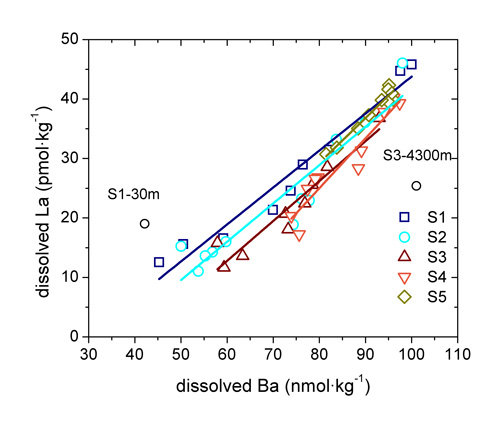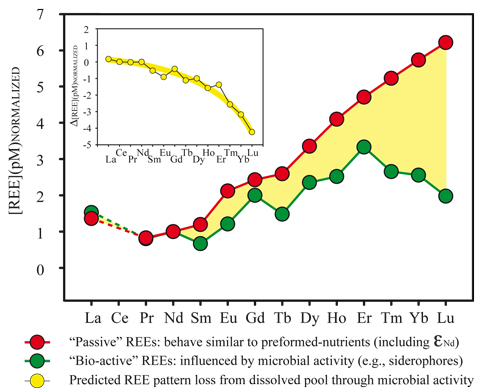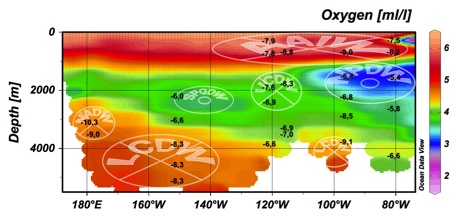New data on oceanic rare earth elements concentrations and neodymium isotopic compositions
Early 2014 was favourable to the publication of new data of rare earth elements (REE) concentrations and neodymium (Nd) isotopic compositions in extreme areas of the ocean: the southern Atlantic Ocean, the north east corner of the Pacific Ocean and the remote south Pacific Ocean. Three works of three different groups (Garcia-Solsona et al.; Haley et al.; Molina-Kescher et al., see references below), all published in Geochimica Cosmochimica Acta on REE distributions.
These three works confirm the conservative behaviour of Nd isotopic composition far from main biogeochemical disturbances, such as lithogenic inputs or significant biological activity. But more importantly, they reveal features in the behaviours of the REE that might need to be considered more closely. These features rely on particle/dissolved exchanges that are not understood yet but they also yield unexpected decoupling along the REE array… Read more to discover the fascinating world of REE and Nd isotopic composition!
In January 2014 (Vol. 125), Garcia-Solsona and co-workers (Toulouse, France) described the distribution of dissolved and particulate REE and seawater Nd isotopic composition in samples from the IPY/GEOTRACES Bonus Good Hope (BGH) cruise between South Africa and the Southern Ocean (57°S). This work:
- demonstrates the role of the South African submarine margins as sources of neodymium;
- shows that at open-ocean stations, dissolved and particulate REEs have acquired a marine signature (particles present negative cerium anomalies) as a result of dissolved/particulate exchange likely driven by the biological activity;
- reports positive Lanthanum (La) anomalies, observed in both particulate and dissolved phases, that could be linked to the oceanic barium cycle and the partial dissolution of barite crystals;
- finds that Nd isotopic composition behaves conservatively in the Antarctic Circumpolar Current (ACC), supporting the use of εNd as a water mass mixing tracer in BGH deep waters.

Figure 1: This figure shows linear correlations between dissolved La and Ba concentrations.
Click here to view the figure larger.
Two weeks later (Vol. 126) Haley and co-workers (Corvallis, USA) presented the first combined distributions of dissolved REEs and Nd isotopes in the Gulf of Alaska. They reveal for the first time that:
- εNd signatures allow tracing eddies that carry shelf waters to open gyre regions;
- two pools of REEs could be distinguished in this productive area using a statistical approach: one pool complexed to carbonate ion and largely behaving “quasi-conservatively”, the second pool “bioreactive” and complexed by organic molecules as siderophores and only significant in the near surface ocean;
- the conservative fraction of the REE and its Nd isotopic composition is consistent with the hypothesis that a pool of seawater older than 1000 years is maintained in this far northeast Pacific Ocean, as already indicated by 14C ages.

Figure 2: REE paterns. Click here to view the image larger.
In early February 2014 (Vol. 127), Molina-Kescher and co-workers (Kiel, Germany) proposed the first detailed analysis of dissolved Nd isotopes and REEs in intermediate and deep waters along a zonal transect between South America and New Zealand (~40°S). These authors:
- confirm the reliability of εNd as water mass tracer in this area;
- propose the tagging of South Pacific water masses never done before. Among others, they identify the influence of residual North Atlantic Deep Water (NADW) in the westernmost South Pacific, characterised by the most negative εNd;
- demonstrate that biogeochemical cycling and scavenging processes in the Eastern Equatorial Pacific and release of LREEs from the sediment in the southeast Pacific Ocean influence the distribution of the dissolved REE concentrations.

Figure 3: Meridional cross section along the South Pacific at ~40°S showing oxygen concentrations (ml/l), represented by the colour gradient, and measured εNd signatures (black values) at their corresponding depths. The flow direction of the water masses are also shown by transparent circles, where crosses represent the sense of movement into the picture and centred dots represent movement out of the picture. Water mass abbreviations: LCDW (Lower Circumpolar Deep Water), NADW (North Atlantic Deep Water), AAIW (Antarctic Intermediate Water), SPGDW (South Pacific Gyre derived Deep Water) and NPDW (North Pacific Deep Water). Oxygen concentrations are from the database of the World Ocean Atlas 09. Click here to view the figure larger.
References:
Garcia-Solsona, E., Jeandel, C., Labatut, M., Lacan, F., Vance, D., Chavagnac, V., & Pradoux, C. (2014). Rare earth elements and Nd isotopes tracing water mass mixing and particle-seawater interactions in the SE Atlantic. Geochimica et Cosmochimica Acta, 125, 351–372. doi:10.1016/j.gca.2013.10.009. Click here to access the paper.
Haley, B. A., Frank, M., Hathorne, E., & Pisias, N. (2014). Biogeochemical implications from dissolved rare earth element and Nd isotope distributions in the Gulf of Alaska. Geochimica et Cosmochimica Acta, 126, 455–474. doi:10.1016/j.gca.2013.11.012. Click here to access the paper.
Molina-Kescher, M., Frank, M., & Hathorne, E. (2014). South Pacific dissolved Nd isotope compositions and rare earth element distributions: Water mass mixing versus biogeochemical cycling. Geochimica et Cosmochimica Acta, 127, 171–189. doi:10.1016/j.gca.2013.11.038. Click here to access the paper.
